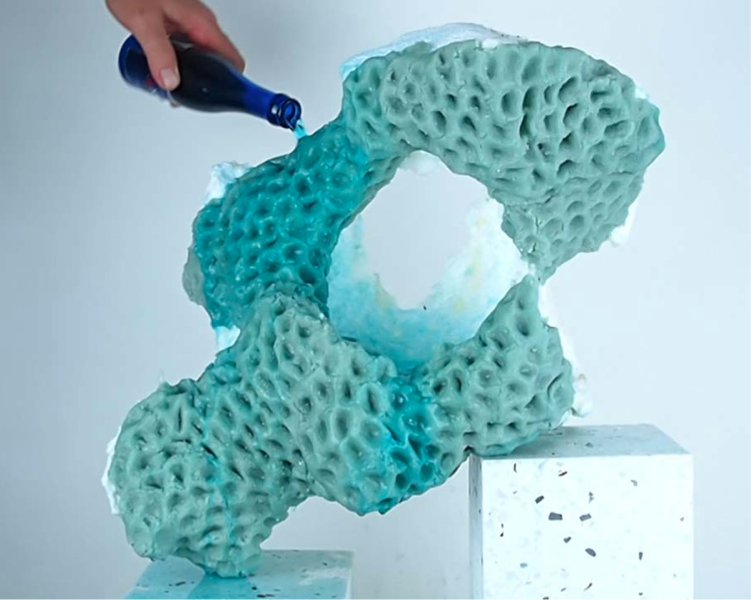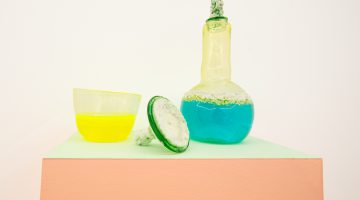Nicolas Lobo is a Miami-based sculptor and installation artist who has been working on conceptual, sometimes site-specific projects since 2006. Recently, however, he has been taking his sensory-imbued practice to new depths by creating work that not only engages in a conversation with itself through its construction, but also relates directly to industries and economies parallel to art discourse that rarely enter into it so distinctly. In his two-week solo exhibition at Gallery Diet in Miami in March 2014, Bad Soda / Soft Drunk, Lobo juxtaposed a grouping of what one might at first glance consider to be relatively formal, even classically contemporary bulbous sculptures that evoke Chinese scholar’s stones with a precarious floor installation that created an entirely new “floor” for the space. Installation shots of the show hardly begin to convey the story that is being told within. The lumpy, dimply sculptures that awkwardly rest atop subtly patterned square columns are in fact created through the process of making napalm. Perhaps even more alarming is the relatively simple process through which such a devastating material is conjured, by pouring gasoline over blocks of polystyrene, a common plastic used for mass-product packaging. To further complicate things, these forms that result in the burning away of plastic are then set with one of the most innocent of children’s delights: Play-Doh, a staple in family homes since the 1950s. The contradictions set into motion by the marriage of these products, repurposed as artistic materials, brings back those unforgettable words of Marshall McLuhan. It seems as though whether or not the medium here truly is the message, or is at least one of several messages, it is impossible not to consider it as both the forefront and the backbone of such a seemingly unthreatening sculpture.
The newly fabricated floor of the gallery likewise brings ingestible and common yet chemically based products into question—or perhaps an odd celebration. From wall to wall the floor of the gallery was filled with unopened, plastic-wrapped, dead-stock 24-packs of a little-known Swedish energy drink called Nexcite that boasts the bonus property of also being an aphrodisiac, particularly for women. It is also notable that Nexcite was originally named Niagara to rhyme with Viagra, which later lead to a lawsuit. Nexcite’s notably Windex-blue coloring warns that there is obviously no telling what has been put into the drink to make you not only energized but exceptionally horny! Visitors had to walk on top of this “flooring” to get from sculpture to sculpture, while in an adjoining minimal room plays a video titled Niagara (2014) of Nexcite being poured on the sculptures, coloring them that bright, artificial blue hue. The absurdity and happenstance that Lobo had even found such a large quantity of Nexcite sitting in a warehouse in an industrial area of Miami is prologue enough to begin the complex and infectious ways that this set of works come together to create this particular and aptly short-lived installation.
Your recent work has utilized materials like cough syrup, perfume, self-made napalm, an outdated Swedish energy/aphrodisiac drink, and Play-Doh, all of which seem to point to an overarching interest in the sensorial—products of various kinds that are made to be ingested or directly engaged with in tactile ways. Do you feel that an investigation of such matter is an underlying aspect of your practice overall or is it something you are just currently interested in?
My interest in those materials has been ongoing. In the last few years I started to think more exclusively about economies radiating from the human body—seeing the body as the fundamental unit of currency, from which all other human economies derived. I think making an object can bring radical awareness of the body. Working through the very old idea that sculpture provides a kind of uncanny physical experience, as opposed to painting, for example, where you might create an opportunity to reflect on the ways images are constructed.
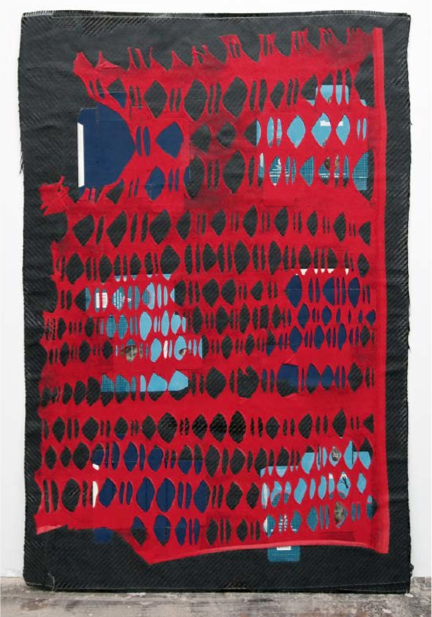
Carbon T-shirt Panel 5, 2014. Carbon fiber, Kevlar thread, t-Shirt, resin, perfume packaging, Velcro. 50 x 36 in. Image Courtesy of Gallery Wendi Norris, San Francisco.
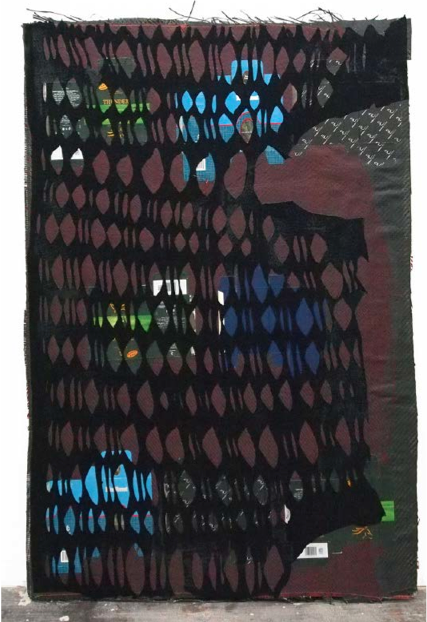
Carbon T-shirt Panel 4, 2014. Carbon fiber, Kevlar thread, t-Shirt, resin, perfume packaging, Velcro. 50 x 36 in. Image Courtesy of Gallery Wendi Norris, San Francisco.
Yes, I have also often used the form and reality of the human body as a productive foil for larger systems at play. Lately I have been noticing more and more contemporary art that takes up materials related to these kinds of sentient ideas in similar ways, particularly food-related products and imagery. Is this something that you have also detected as becoming more prevalent in art and discourse, and can you discuss your own reasons for beginning this pursuit or why you feel it is becoming more of a “hot topic,” so to speak?
Maybe it has to do with the rapid transmission of complex physical qualities. Zoloft and antifreeze: an emotional panacea; Neutrogena skin cream and generic nutritional supplement powder: a body-image crisis, etc. Although materials like these are having a moment I think they really have a lineage that supports their use in historical tradition. I’m thinking of Sigmar Polke, Dieter Roth, and Paul McCarthy, for example. When I look at it this way, the idea of an apocryphal material as a conceptual container is more present in culture as a whole. Maybe this works in counterpoint to the virtual, post-Internet idea that has also been circulating recently; a vague notion caused by viral brand awareness, industrial agriculture, pharmaceutical marketing, and so on that the non-virtual is still here, but it’s getting kind of complicated.
Right, and seemingly that complication is at least in part because they are somehow blending, or the differentiation between the non-virtual and the virtual is narrowing significantly. With Bad Soda / Soft Drunk, you filled a Miami gallery with thousands of old, dead stock bottles of Nexcite and created a sculptural “floor” upon which viewers had to carefully walk. You also included sculptures created by making your own DIY napalm, some of which were then colored with the blue Nexcite. I am wondering if this process in and of itself was meant in some way to serve as a kind of narrative that the show as a whole projects? Process as narrative is something that I’m okay with. There are so many phases to any presentation it would be a shame to underplay the importance of the process. In fact, I’m working on an upcoming project in which the process is even more foregrounded. I think in terms of exhibitions as temporary breaks in ongoing activities.
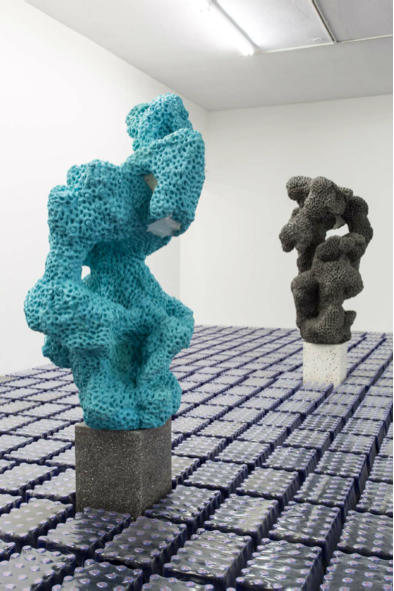
Bad soda/Soft drunk, 2014 . Installation view. Image courtesy of the artist and Gallery Diet.
When I was making the Bad Soda / Soft Drunk show I was seeing the elements as temporary states, agglomerations of products designed for the skin, tools for tactile contemplation, extreme physical violence, and sensual awareness. When combined they inform each other but also call attention to the idea that they are made of other products, which are in turn made from other products. Napalm is gasoline and polystyrene—gasoline is refined petroleum, and polystyrene is a collection of various engineered molecules in the styrene family. As you start to look further down the chain these things start to change shape pretty aggressively. I’m thinking of the human body as a kind of hub through which these various commodities pass before moving on to other forms, states, and effects.
Yes, certainly it is clear that a lineage of some kind is being either formed or followed, or in some way is doing both at once. Since there is a drastic dichotomy at the crux of this body of work that simultaneously produces playful, colorful sculptures that are made up of toxic, chemically modified products that are manufactured for less-than-playful, innocent purposes, I am curious as to what story, if any, the marriage of these two extremes may tell?
When I choose to use napalm, I am interested in it because most people know what it is but very few have experienced it first hand. It’s a mythologized material designed for the skin, but it also represents certain political agendas. The failed Swedish aphrodisiac drink has some opposing qualities: it’s essentially sugar water—a placebo—but it has a very specific mythology ascribed to it in which physiological changes are supposed to take place.
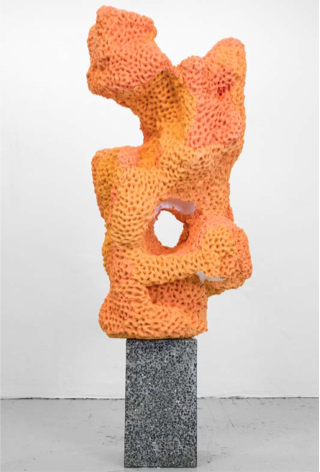
Napalm Stone (Bronzer Version #1), 2014. Napalm, play-dough, spray bronzer, terrazzo. 69 x 30 x 22 in. Image Courtesy of Gallery Wendi Norris, San Francisco.
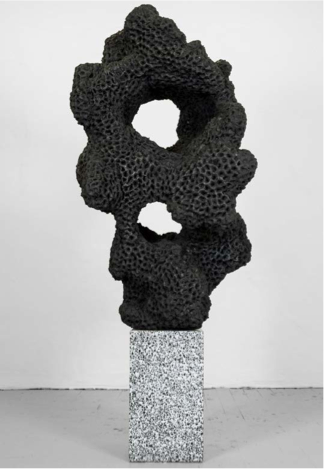
Napalm Stone (Graphite Version #1), 2014. Napalm, play-dough, powdered graphite, terrazzo. 67 x 30 x 22 in. Image Courtesy of Gallery Wendi Norris, San Francisco.
Setting up a dichotomy is very useful since it creates a third field that holds the part I think of as the artwork. I’m interested in finding ways to move outside of language. I try to think in terms of creating displays that elicit non-verbal responses. The blind finger-poke texture and the absurdity of the forms perched on small concrete plinths come from a place of hyper-dumbness that hopefully leads to a state for which language has to be invented rather than chosen.
I definitely like the idea of artwork that demands a new kind of language in order to accurately or appropriately discuss it, rather than sort of mad-libbing of concepts that have already been applied to other types of work. Nonetheless, many of these kinds of ingestible materials that we are discussing, as you said, already have a whole mythology, and therefore a history embedded into them, particularly the politics of napalm. How do you approach the challenge of utilizing such products to say something else?
That’s a good point, It’s rare to get outside of existing ideas and meanings. Especially in a knowledge-economy where everything is named, categorized, and photographed. What do you think about gravitating towards liminal materials? When I say liminal materials I mean things that are on the fringe of collective knowledge—exotic and obscure things. By starting towards the edge is it more possible to slip over from time? While the liminal materials I like to use do have meanings and associations they are more tenuously attached as opposed to the connections of Coca-Cola or Vaseline, for example. It’s always a game of trial and error, right?
Yes, I would think so. I also liked what you said about the third, lovechild-like field of thought and representation that comes out of a framework rooted in a blatant dichotomy. I sense that that may very well be where this new mode of language that you mentioned is generated.
Yes, the third place could be some kind of temporary truth-state where one’s interpretations are not distorted by the ambiguity of language. The two opposing perceptions wrapped in language are set into motion and with some luck they arrive at a momentary state of perceptual “truth” in which there is no linguistic buffer to cloud the experience. I like the term “lovechild-like field of thought.” Being that you work with language often, is this an idea you have encountered in the past?
Not exactly, I don’t think I have ever phrased it quite like that, but so many of the most intriguing concepts and works of art represent an inherent kind of hybridity, so I guess that quality is like a lovechild.
I think of the particle accelerators. Giant, highway-sized circular pathways in which existing elements are smashed together at great speed to occasionally produce exotic new ones for fractions of a second. Of course the new elements are impractical because of their extremely short duration. Similar to when something completely unfamiliar is apprehended, language rushes up to envelop it and fill the void. It’s a funny thing, by trying to escape language we are generating it.
That is certainly true. This attempt to move away from verbal responses or configure new ways of using language to discuss the meaning of a work of art also makes me think of something you said in an interview in Blouin from December 2011, which was, “I think obsolescence is the format of progress.” I would often tend to agree, but I am curious if you can expand upon how the idea of the obsolete actually begins to generate what we would consider to be new ideas or at least contexts in which to discuss contemporary art. It reminds me of another quote by fashion designer Yohji Yamamoto that I recently read that said, “To be modern is to tear the soul out of everything.” Does that resonate with you on a similar level?
It’s interesting that you bring up fashion where the “new” is so highly codified through a seasonal mechanism. I was not aware of those words from Mr. Yamamoto but I would not disagree with him. I cannot say that I know what it means to be modern as I am from a different generation. I don’t even think I know much about being post-modern. I hesitate to identify something as new or original. I think it’s one of the central contradictions of this thing we are participating in—this tradition. One idea does stick with me and it is that what we do must be disruptive, not only outwardly but inwardly as well. The work I admire and am interested in doing is always designed for its own eventual failure.
